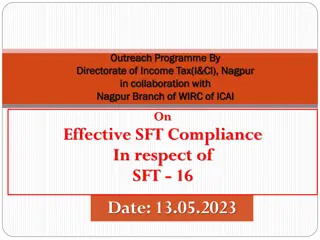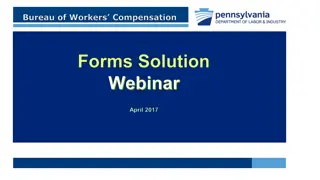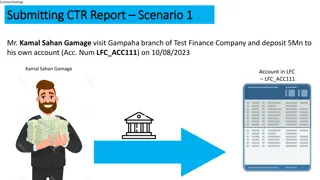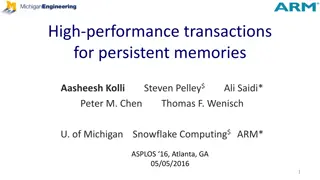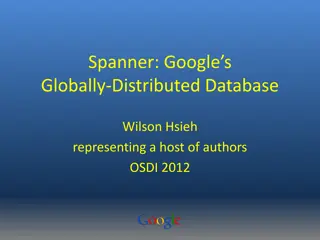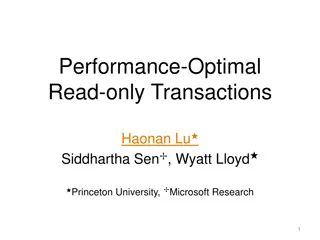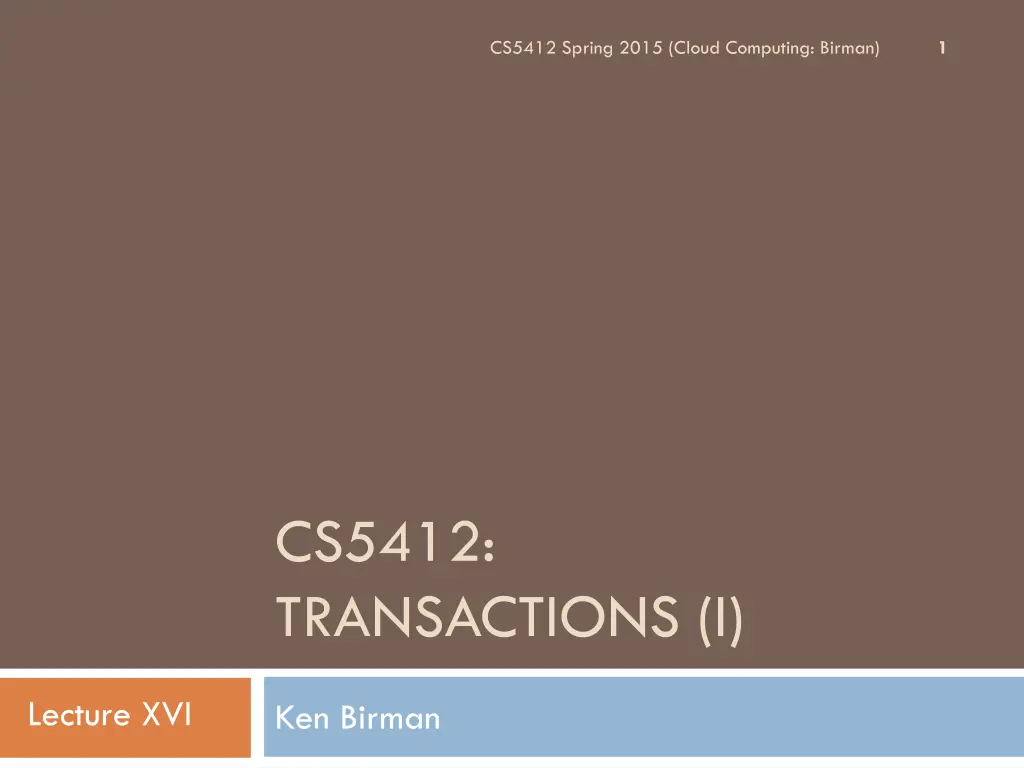
Understanding Transactional Systems in Cloud Computing
Delve into the functionality and implementation of transactional systems in cloud computing. Explore the nuances of reliability technology, ACID properties, CAP conjecture, and real-world applications. Discover the intricacies of managing transactions on a single database, achieving reliability, and addressing scalability challenges in cloud environments.
Download Presentation

Please find below an Image/Link to download the presentation.
The content on the website is provided AS IS for your information and personal use only. It may not be sold, licensed, or shared on other websites without obtaining consent from the author. If you encounter any issues during the download, it is possible that the publisher has removed the file from their server.
You are allowed to download the files provided on this website for personal or commercial use, subject to the condition that they are used lawfully. All files are the property of their respective owners.
The content on the website is provided AS IS for your information and personal use only. It may not be sold, licensed, or shared on other websites without obtaining consent from the author.
E N D
Presentation Transcript
CS5412 Spring 2015 (Cloud Computing: Birman) 1 CS5412: TRANSACTIONS (I) Lecture XVI Ken Birman
Transactions 2 A widely used reliability technology, despite the BASE methodology we use in the first tier Goal for this week: in-depth examination of topic How transactional systems really work Implementation considerations Limitations and performance challenges Scalability of transactional systems Topic will span two lectures CS5412 Spring 2015 (Cloud Computing: Birman)
Transactions 3 There are several perspectives on how to achieve reliability We ve talked at some length about non-transactional replication via multicast Another approach focuses on reliability of communication channels and leaves application- oriented issues to the client or server stateless But many systems focus on the data managed by a system. This yields transactional applications CS5412 Spring 2015 (Cloud Computing: Birman)
Transactions on a single database: 4 In a client/server architecture, A transaction is an execution of a single program of the application(client) at the server. Seen at the server as a series of reads and writes. We want this setup to work when There are multiple simultaneous client transactions running at the server. Client/Server could fail at any time. CS5412 Spring 2015 (Cloud Computing: Birman)
The ACID Properties 5 Atomicity All or nothing. Consistency: Each transaction, if executed by itself, maintains the correctness of the database. Isolation (Serializability) Transactions won t see partially completed results of other non-commited transactions Durability Once a transaction commits, future transactions see its results CS5412 Spring 2015 (Cloud Computing: Birman)
CAP conjecture 6 Recall Brewer s CAP theorem: you can t use transactions at large scale in the cloud . We saw that the real issue is mostly in the highly scalable and elastic outer tier ( stateless tier ). In fact cloud systems use transactions all the time, but they do so in the back end , and they shield that layer as much as they can to avoid overload CS5412 Spring 2015 (Cloud Computing: Birman)
Transactions in the real world 7 In cs5142 lectures, transactions are treated at the same level as other techniques But in the real world, transactions represent a huge chunk (in $ value) of the existing market for distributed systems! The web is gradually starting to shift the balance (not by reducing the size of the transaction market but by growing so fast that it is catching up) On the web, we use transactions when we buy products So the real reason we don t emphasize them is this issue of them not working well in the first tier CS5412 Spring 2015 (Cloud Computing: Birman)
The transactional model 8 Applications are coded in a stylized way: begin transaction Perform a series of read, update operations Terminate by commit or abort. Terminology The application is the transaction manager The data manager is presented with operations from concurrently active transactions It schedules them in an interleaved but serializable order CS5412 Spring 2015 (Cloud Computing: Birman)
A side remark 9 Each transaction is built up incrementally Application runs And as it runs, it issues operations The data manager sees them one by one But often we talk as if we knew the whole thing at one time We re careful to do this in ways that make sense In any case, we usually don t need to say anything until a commit is issued CS5412 Spring 2015 (Cloud Computing: Birman)
Transaction and Data Managers 10 Transactions Data (and Lock) Managers read update read update transactions are stateful: transaction knows about database contents and updates CS5412 Spring 2015 (Cloud Computing: Birman)
Typical transactional program 11 begin transaction; x = read( x-values , ....); y = read( y-values , ....); z = x+y; write( z-values , z, ....); commit transaction; CS5412 Spring 2015 (Cloud Computing: Birman)
What about locks? 12 Unlike some other kinds of distributed systems, transactional systems typically lock the data they access They obtain these locks as they run: Before accessing x get a lock on x Usually we assume that the application knows enough to get the right kind of lock. It is not good to get a read lock if you ll later need to update the object In clever applications, one lock will often cover many objects CS5412 Spring 2015 (Cloud Computing: Birman)
Locking rule 13 Suppose that transaction T will access object x. We need to know that first, T gets a lock that covers x What does coverage entail? We need to know that if any other transaction T tries to access x it will attempt to get the same lock CS5412 Spring 2015 (Cloud Computing: Birman)
Examples of lock coverage 14 We could have one lock per object or one lock for the whole database or one lock for a category of objects In a tree, we could have one lock for the whole tree associated with the root In a table we could have one lock for row, or one for each column, or one for the whole table All transactions must use the same rules! And if you will update the object, the lock must be a write lock, not a read lock CS5412 Spring 2015 (Cloud Computing: Birman)
Transactional Execution Log 15 As the transaction runs, it creates a history of its actions. Suppose we were to write down the sequence of operations it performs. Data manager does this, one by one This yields a schedule Operations and order they executed Can infer order in which transactions ran Scheduling is called concurrency control CS5412 Spring 2015 (Cloud Computing: Birman)
Observations 16 Program runs by itself , doesn t talk to others All the work is done in one program, in straight-line fashion. If an application requires running several programs, like a C compilation, it would run as several separate transactions! The persistent data is maintained in files or database relations external to the application CS5412 Spring 2015 (Cloud Computing: Birman)
Serializability 17 Means that effect of the interleaved execution is indistinguishable from some possible serial execution of the committed transactions For example: T1 and T2 are interleaved but it looks like T2 ran before T1 Idea is that transactions can be coded to be correct if run in isolation, and yet will run correctly when executed concurrently (and hence gain a speedup) CS5412 Spring 2015 (Cloud Computing: Birman)
Need for serializable execution 18 T1: R1(X) R1(Y) W1(X)commit1 T2: R2(X) W2(X) W2(Y) commit2 DB: R1(X) R2(X) W2(X) R1(Y) W1(X) W2(Y) commit1 commit2 Data manager interleaves operations to improve concurrency CS5412 Spring 2015 (Cloud Computing: Birman)
Non serializable execution 19 T1: R1(X) R1(Y) W1(X)commit1 T2: R2(X) W2(X) W2(Y) commit2 DB: R1(X) R2(X) W2(X) R1(Y) W1(X) W2(Y) commit2 commit1 Unsafe! Not serializable Problem: transactions may interfere . Here, T2 changes x, hence T1 should have either run first (read and write) or after (reading the changed value). CS5412 Spring 2015 (Cloud Computing: Birman)
Serializable execution 20 T1: R1(X) R1(Y) W1(X)commit1 T2: R2(X) W2(X) W2(Y) commit2 DB: R2(X) W2(X) R1(X) R1(Y) W2(Y) W1(X) commit2 commit1 Data manager interleaves operations to improve concurrency but schedules them so that it looks as if one transaction ran at a time. This schedule looks like T2 ran first. CS5412 Spring 2015 (Cloud Computing: Birman)
Atomicity considerations 21 If application ( transaction manager ) crashes, treat as an abort If data manager crashes, abort any non-committed transactions, but committed state is persistent Aborted transactions leave no effect, either in database itself or in terms of indirect side-effects Only need to consider committed operations in determining serializability CS5412 Spring 2015 (Cloud Computing: Birman)
Components of transactional system 22 Runtime environment: responsible for assigning transaction id s and labeling each operation with the correct id. Concurrency control subsystem: responsible for scheduling operations so that outcome will be serializable Data manager: responsible for implementing the database storage and retrieval functions CS5412 Spring 2015 (Cloud Computing: Birman)
Transactions at a single database 23 Normally use 2-phase locking or timestamps for concurrency control Intentions list tracks intended updates for each active transaction Write-ahead log used to ensure all-or-nothing aspect of commit operations Can achieve thousands of transactions per second CS5412 Spring 2015 (Cloud Computing: Birman)
Strict two-phase locking: how it works 24 Transaction must have a lock on each data item it will access. Gets a write lock if it will (ever) update the item Use read lock if it will (only) read the item. Can t change its mind! Obtains all the locks it needs while it runs and hold onto them even if no longer needed Releases locks only after making commit/abort decision and only after updates are persistent CS5412 Spring 2015 (Cloud Computing: Birman)
Why do we call it Strict two phase? 25 2-phase locking: Locks only acquired during the growing phase, only released during the shrinking phase. Strict: Locks are only released after the commit decision Read locks don t conflict with each other (hence T can read x even if T holds a read lock on x) Update locks conflict with everything (are exclusive ) CS5412 Spring 2015 (Cloud Computing: Birman)
Strict Two-phase Locking 26 T1: begin read(x) read(y) write(x) commit T2: begin read(x) write(x) write(y) commit Acquires locks Releases locks CS5412 Spring 2015 (Cloud Computing: Birman)
Notes 27 Notice that locks must be kept even if the same objects won t be revisited This can be a problem in long-running applications! Also becomes an issue in systems that crash and then recover Often, they forget locks when this happens Called broken locks . We say that a crash may break current locks CS5412 Spring 2015 (Cloud Computing: Birman)
Why does strict 2PL imply serializability? 28 Suppose that T will perform an operation that conflicts with an operation that T has done: T will update data item X that T read or updated T updated item Y and T will read or update it T must have had a lock on X/Y that conflicts with the lock that T wants T won t release it until it commits or aborts So T will wait until T commits or aborts CS5412 Spring 2015 (Cloud Computing: Birman)
Acyclic conflict graph implies serializability 29 Can represent conflicts between operations and between locks by a graph (e.g. first T1 reads x and then T2 writes x) If this graph is acyclic, can easily show that transactions are serializable Two-phase locking produces acyclic conflict graphs CS5412 Spring 2015 (Cloud Computing: Birman)
Two-phase locking is pessimistic 30 Acts to prevent non-serializable schedules from arising: pessimistically assumes conflicts are fairly likely Can deadlock, e.g. T1 reads x then writes y; T2 reads y then writes x. This doesn t always deadlock but it is capable of deadlocking Overcome by aborting if we wait for too long, Or by designing transactions to obtain locks in a known and agreed upon ordering CS5412 Spring 2015 (Cloud Computing: Birman)
Contrast: Timestamped approach 31 Using a fine-grained clock, assign a time to each transaction, uniquely. E.g. T1 is at time 1, T2 is at time 2 Now data manager tracks temporal history of each data item, responds to requests as if they had occured at time given by timestamp At commit stage, make sure that commit is consistent with serializability and, if not, abort CS5412 Spring 2015 (Cloud Computing: Birman)
Example of when we abort 32 T1 runs, updates x, setting to 3 T2 runs concurrently but has a larger timestamp. It reads x=3 T1 eventually aborts ... T2 must abort too, since it read a value of x that is no longer a committed value Called a cascaded abort since abort of T1 triggers abort of T2 CS5412 Spring 2015 (Cloud Computing: Birman)
Pros and cons of approaches 33 Locking scheme works best when conflicts between transactions are common and transactions are short- running Timestamped scheme works best when conflicts are rare and transactions are relatively long-running Weihl has suggested hybrid approaches but these are not common in real systems CS5412 Spring 2015 (Cloud Computing: Birman)
Intentions list concept 34 Idea is to separate persistent state of database from the updates that have yet to commit Many systems update in place, roll back on abort. For these, a log of prior versions is needed. A few systems flip this and keep a list of what changes they intend to make. Intensions list may simply be the in-memory cached database state (e.g. change a cached copy, but temporarily leave the disk copy). Either way, as a transaction runs it builds a set of updates that it intends to commit, if it commits CS5412 Spring 2015 (Cloud Computing: Birman)
Role of write-ahead log 35 Used to save either old or new state of database to either permit abort by rollback (need old state) or to ensure that commit is all-or-nothing (by being able to repeat updates until all are completed) Rule is that log must be written before database is modified After commit record is persistently stored and all updates are done, can erase log contents CS5412 Spring 2015 (Cloud Computing: Birman)
Structure of a transactional system 36 application cache (volatile) lock records updates (persistent) log database CS5412 Spring 2015 (Cloud Computing: Birman)
Recovery? 37 Transactional data manager reboots It rescans the log Ignores non-committed transactions Reapplies any updates These must be idempotent Can be repeated many times with exactly the same effect as a single time E.g. x := 3, but not x := x.prev+1 Then clears log records (In normal use, log records are deleted once transaction commits) CS5412 Spring 2015 (Cloud Computing: Birman)
Transactions in distributed systems 38 Notice that client and data manager might not run on same computer Both may not fail at same time Also, either could timeout waiting for the other in normal situations When this happens, we normally abort the transaction Exception is a timeout that occurs while commit is being processed If server fails, one effect of crash is to break locks even for read-only access CS5412 Spring 2015 (Cloud Computing: Birman)
Transactions in distributed systems 39 What if data is on multiple servers? In a non-distributed system, transactions run against a single database system Indeed, many systems structured to use just a single operation a one shot transaction! In distributed systems may want one application to talk to multiple databases CS5412 Spring 2015 (Cloud Computing: Birman)
Transactions in distributed systems 40 Main issue that arises is that now we can have multiple database servers that are touched by one transaction Reasons? Data spread around: each owns subset Could have replicated some data object on multiple servers, e.g. to load-balance read access for large client set Might do this for high availability Solve using 2-phase commit protocol! CS5412 Spring 2015 (Cloud Computing: Birman)
Unilateral abort 41 Any data manager can unilaterally abort a transaction until it has said prepared Useful if transaction manager seems to have failed Also arises if data manager crashes and restarts (hence will have lost any non-persistent intended updates and locks) Implication: even a data manager where only reads were done must participate in 2PC protocol! CS5412 Spring 2015 (Cloud Computing: Birman)
Transactions on distributed objects 42 Idea was proposed by Liskov s Argus group and then became popular again recently Each object translates an abstract set of operations into the concrete operations that implement it Result is that object invocations may nest : Library update operations, do A series of file read and write operations that do A series of accesses to the disk device CS5412 Spring 2015 (Cloud Computing: Birman)
Nested transactions 43 Call the traditional style of flat transaction a top level transaction Argus short hand: actions The main program becomes the top level action Within it objects run as nested actions CS5412 Spring 2015 (Cloud Computing: Birman)
Arguments for nested transactions 44 It makes sense to treat each object invocation as a small transaction: begin when the invocation is done, and commit or abort when result is returned Can use abort as a tool : try something; if it doesn t work just do an abort to back out of it. Turns out we can easily extend transactional model to accommodate nested transactions Liskov argues that in this approach we have a simple conceptual framework for distributed computing CS5412 Spring 2015 (Cloud Computing: Birman)
Nested transactions: picture 45 T1: fetch( ken ) .... set_salary( ken , 100000) ... commit open_file ... seek... read seek... write... ... lower level operations... CS5412 Spring 2015 (Cloud Computing: Birman)
Observations 46 Can number operations using the obvious notation T1, T1.2.1..... Subtransaction commit should make results visible to the parent transaction Subtransaction abort should return to state when subtransaction (not parent) was initiated Data managers maintain a stack of data versions CS5412 Spring 2015 (Cloud Computing: Birman)
Stacking rule 47 Abstractly, when subtransaction starts, we push a new copy of each data item on top of the stack for that item When subtransaction aborts we pop the stack When subtransaction commits we pop two items and push top one back on again In practice, can implement this much more efficiently!!! CS5412 Spring 2015 (Cloud Computing: Birman)
Data objects viewed as stacks 48 Transaction T0 wrote 6 into x Transaction T1 spawned subtransactions that wrote new values for y and z -2 T1.1.1 T1.1.1 15 T1.1 6 13 T0 T1.1 30 17 1 18 x y z CS5412 Spring 2015 (Cloud Computing: Birman)
Locking rules? 49 When subtransaction requests lock, it should be able to obtain locks held by its parent Subtransaction aborts, locks return to prior state Subtransaction commits, locks retained by parent ... Moss has shown that this extended version of 2- phase locking guarantees serializability of nested transactions CS5412 Spring 2015 (Cloud Computing: Birman)
Relatively recent developments 50 Many cloud-computing solutions favor non- transactional tables to reduce delays even if consistency is much weaker Called the NoSQL movement: Not SQL Application must somehow cope with inconsistencies and failure issues. E.g. your problem, not the platform s. Also widely used: a model called Snapshot isolation . Gives a form of consistency for reads and for updates, but not full serializability CS5412 Spring 2015 (Cloud Computing: Birman)











